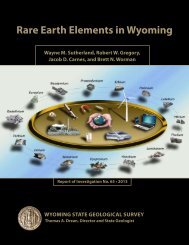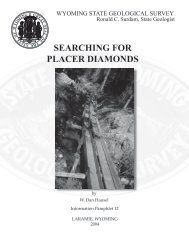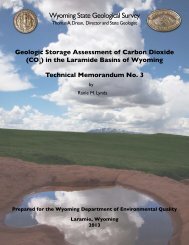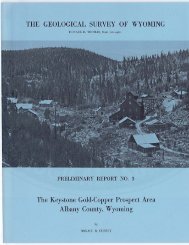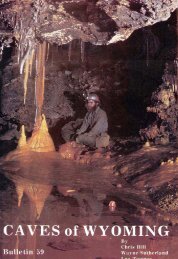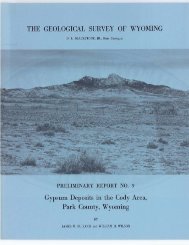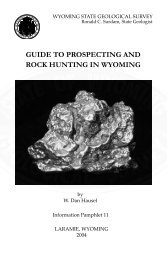The Dinosaurs of Wyoming - Wyoming State Geological Survey ...
The Dinosaurs of Wyoming - Wyoming State Geological Survey ...
The Dinosaurs of Wyoming - Wyoming State Geological Survey ...
You also want an ePaper? Increase the reach of your titles
YUMPU automatically turns print PDFs into web optimized ePapers that Google loves.
THE AMPHIBIOUS DINOSA URIA 87<br />
quirements and its inadequate food-getting mechanisms were<br />
undoubtedly critical factors in the extinction <strong>of</strong> this type <strong>of</strong><br />
the dinosaurs, which did not survive beyond the Lower Cretaceous.<br />
\Vyoming localities furnishing parts <strong>of</strong> the Brontosaurus<br />
skeleton mounted in the American Museum, are Nine Mile<br />
Crossing <strong>of</strong> the Little Medicine Bow River, Como Bluffs, and<br />
the Bone Cabin Quarry. Another dinosaur <strong>of</strong> this group<br />
reaching a length <strong>of</strong> 87 feet, was also found in <strong>Wyoming</strong>.<br />
A number <strong>of</strong> writers, notably Williston, Wieland, and<br />
Brown, have discussed the significance <strong>of</strong> certain smooth,<br />
rounded pebbles found associated within the ribs <strong>of</strong> certain<br />
Mesozoic reptiles. <strong>The</strong>se are <strong>of</strong>ten <strong>of</strong> rock which could only<br />
have been secured at a considerable distance from where they<br />
were found. Such pebbles are now called "gizzard stones,"<br />
"stomach stones," or "gastroliths." Wieland in his discussion<br />
<strong>of</strong> the sauropod dinosaur Barosaurus, says:<br />
" ... various pebbles <strong>of</strong> a singular smoothness were noted<br />
at only one point close to the main group <strong>of</strong> dorsals. As the<br />
specimen was incomplete the reasonable explanation that these<br />
were stomach stones, or as later called, dinosaurian gastroliths,<br />
did not then occur to me, their true character being first recognized<br />
in examples from the Big Horn mountains."<br />
It is well known today how certain birds and reptiles swallow<br />
stones to aid in digestion. I noted a similar habit among<br />
the horned toads which feeding on ants had added various<br />
quartz pebbles to its stomach contents. So far the amphibious<br />
dinosaurs are the only ones known to have had this<br />
habit.





